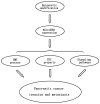microRNA signature for human pancreatic cancer invasion and metastasis
- PMID: 22970025
- PMCID: PMC3439005
- DOI: 10.3892/etm.2012.585
microRNA signature for human pancreatic cancer invasion and metastasis
Abstract
Pancreatic cancer has the poorest prognosis among all human malignant solid tumors, mainly due to its high invasive and metastatic biological features. microRNAs (miRNAs) are a group of endogenous and small non-coding RNA molecules 18-25 nucleotides in length, functioning as either tumor-suppressor genes or oncogenes. Evidence has shown that regulation of miRNAs in pancreatic cancer is associated with tumor growth, invasion, metastasis and resistance to therapy. Over the last decade, many studies have also found that there is a close relationship between miRNAs and biological characteristics of pancreatic cancer invasion and metastasis, such as the presence of cancer stem cells, epithelial-mesenchymal transition (EMT) phenotype, DNA methylation or epigenetic alteration, and the activation of some specific signaling pathways. Therefore, better understanding of the complex role of miRNAs in the development and progression of pancreatic cancer metastasis may provide new insights that could be of therapeutic consequence. In this brief review, we discuss the literature concerning the correlation between miRNAs and pancreatic cancer, focusing on miRNAs that contribute to pancreatic cancer invasion and metastasis, particularly on cancer stem cell characteristics, the EMT process, epigenetic modifications and tumor-associated signaling pathways.
Figures
Similar articles
-
Role of exosomal microRNA-125b-5p in conferring the metastatic phenotype among pancreatic cancer cells with different potential of metastasis.Life Sci. 2020 Aug 15;255:117857. doi: 10.1016/j.lfs.2020.117857. Epub 2020 May 27. Life Sci. 2020. PMID: 32470446
-
Advance in microRNA as a potential biomarker for early detection of pancreatic cancer.Biomark Res. 2016 Oct 22;4:20. doi: 10.1186/s40364-016-0074-3. eCollection 2016. Biomark Res. 2016. PMID: 27795830 Free PMC article. Review.
-
MicroRNAs as the critical regulators of cell migration and invasion in thyroid cancer.Biomark Res. 2022 Jun 4;10(1):40. doi: 10.1186/s40364-022-00382-4. Biomark Res. 2022. PMID: 35659780 Free PMC article. Review.
-
MicroRNAs as the critical regulators of epithelial mesenchymal transition in pancreatic tumor cells.Heliyon. 2024 May 1;10(9):e30599. doi: 10.1016/j.heliyon.2024.e30599. eCollection 2024 May 15. Heliyon. 2024. PMID: 38726188 Free PMC article. Review.
-
MicroRNA-296-5p Promotes Cell Invasion and Drug Resistance by Targeting Bcl2-Related Ovarian Killer, Leading to a Poor Prognosis in Pancreatic Cancer.Digestion. 2020;101(6):794-806. doi: 10.1159/000503225. Epub 2019 Sep 27. Digestion. 2020. PMID: 31563901
Cited by
-
Genomics, microRNA, epigenetics, and proteomics for future diagnosis, treatment and monitoring response in upper GI cancers.Clin Transl Med. 2016 Mar;5(1):13. doi: 10.1186/s40169-016-0093-6. Epub 2016 Apr 6. Clin Transl Med. 2016. PMID: 27053248 Free PMC article. Review.
-
MicroRNA-103a inhibits gastric cancer cell proliferation, migration and invasion by targeting c-Myb.Cell Prolif. 2015 Feb;48(1):78-85. doi: 10.1111/cpr.12159. Epub 2014 Dec 22. Cell Prolif. 2015. PMID: 25530421 Free PMC article.
-
MicroRNA in pancreatic adenocarcinoma: predictive/prognostic biomarkers or therapeutic targets?Oncotarget. 2015 Sep 15;6(27):23323-41. doi: 10.18632/oncotarget.4492. Oncotarget. 2015. PMID: 26259238 Free PMC article. Review.
-
The clinical significance of microRNA-409 in pancreatic carcinoma and associated tumor cellular functions.Bioengineered. 2021 Dec;12(1):4633-4642. doi: 10.1080/21655979.2021.1956404. Bioengineered. 2021. PMID: 34338153 Free PMC article.
-
Extensive cutaneous metastases of pancreatic adenocarcinoma: a case report and review of the literature.Clin Case Rep. 2016 Dec 20;5(1):51-56. doi: 10.1002/ccr3.737. eCollection 2017 Jan. Clin Case Rep. 2016. PMID: 28096990 Free PMC article.
References
-
- Jemal A, Siegel R, Xu J, Ward E. Cancer statistics, 2010. CA Cancer J Clin. 2010;60:277–300. - PubMed
-
- Zuckerman DS, Ryan DP. Adjuvant therapy for pancreatic cancer: a review. Cancer. 2008;112:243–249. - PubMed
-
- Esquela-Kerscher A, Slack FJ. Oncomirs - microRNAs with a role in cancer. Nat Rev Cancer. 2006;6:259–269. - PubMed
-
- Denli AM, Tops BB, Plasterk RH, Ketting RF, Hannon GJ. Processing of primary microRNAs by the microprocessor complex. Nature. 2004;432:231–235. - PubMed
-
- Wightman B, Ha I, Ruvkun G. Posttranscriptional regulation of the heterochronic gene lin-14 by lin-4 mediates temporal pattern formation in C. elegans. Cell. 1993;75:855–862. - PubMed
LinkOut - more resources
Full Text Sources


